(Warning: long)
I received an invitation over Sanzui last night from a tea friend (let’s call him W) whom I shopped at Maliandao with a few weeks ago to drink tea at his friend’s teashop and then go back to his place. I figured what the heck, might as well, so I went. I know he has a big stash of tea, so I wanted to see it. He is also serving a bit as the puerh advisor to his friend’s teahouse, where he goes and shops for stuff that he finds appealing, and then goes with his friends to do the buying.
We first went to his friend’s teashop, which is in a building that houses mostly stores for art and paintings and calligraphy (and paraphrenalia), as well as a few teashops. They’ve called themselves, at least at that corner, the “West Side Tea City”. It’s a bit further from my house than Maliandao, but there’s a nice little operation going on, with 5-6 teashops on the second floor of this mall-like-thing. We went into an enclosed space within his friend’s shop where he stocks his higher priced yixings, and started tasting stuff.
The first up is a Nanzhao cake, I think 2004.
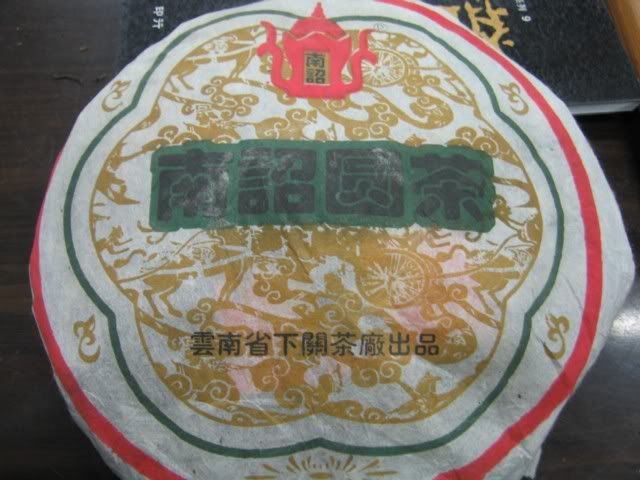
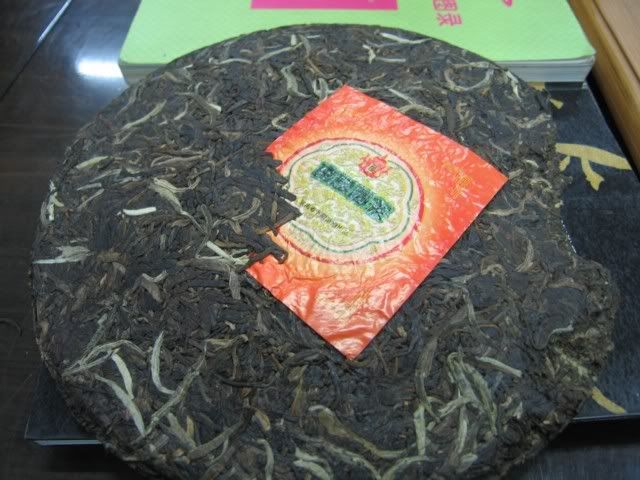

This is made by the order from Feitai, a tea company from Taiwan. W likes their teas, apparently, and bought lots of them over the last few years. Feitai just opened a store recently in Maliandao, but their wholesale prices (W buys by the jian) is even HIGHER than some other stores on Maliandao selling the same stuff. Go figure.
The Nanzhao cake is….. well, like a regular Xiaguan puerh type taste. Bitter, astringent, a bit rough. Bitter is the most obvious taste. Much of the flavours/aromas/feelings stay on the first 2/3 of the tongue, and the back of your mouth gets nothing… I can’t feel much of anything at all, sweet, bitter, or minty, in the back. This is plantation tea par excellence. There’s supposed to be Banzhang leaves mixed in it, but my friend said after going through the wet leaves very thorougly before, he found maybe a 1:20 ratio of Banzhang:other stuff.
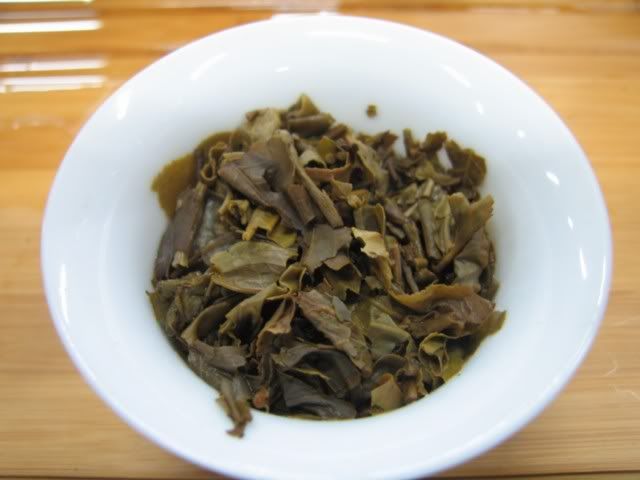
Nothing really interesting. Overpriced to boot. Why do people drink this stuff? It’s so overpressed I can’t imagine it aging quickly or well at all without some years devoted to it. In fact, in a dry climate like Beijing…. I honestly don’t know what will happen to something like this.
Then we started on a cooked puerh. This is a 2003 (?) mini cake of Golden Needle White Lotus from Menghai. There’s no wrapper — just the tea. The wrapper is a white cotton paper.
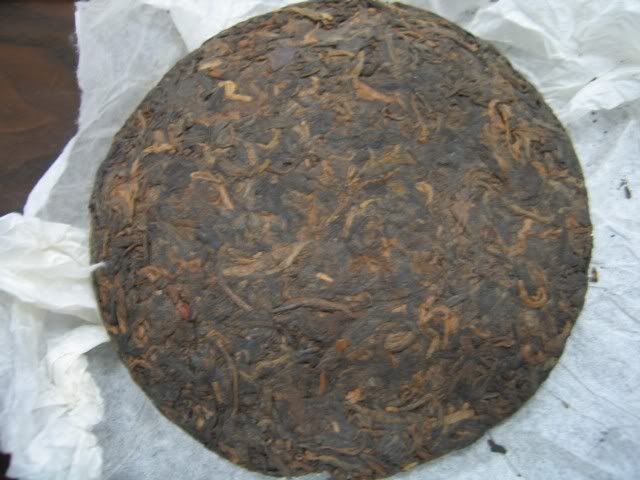
Price is almost the same as the Nanzhao. Daylight robbery.
This is the wet leaves

Cooked puerh is cooked puerh. I don’t usually put much stock in it, and this one is the same. Why drink cooked puerh when you can drink a nice roasted oolong?
Then we tried ANOTHER cooked puerh. I didn’t really feel like it, but since I am the guest, I didn’t want to say too much. I didn’t take pictures, but actually, this one’s not bad. It’s a “Purple Sky” cooked puerh, made by the request of Nantian Company in Hong Kong in the 90s. It’s called “Purple Sky” because on the wrapper is a purple seal with the Chinese character “sky” on it. Not cheap.
However, it’s quite nice. Drinking it right after the Golden Needle White Lotus, you can really tell the difference, and the Purple Sky wins hands down. Now, even if you factor in the price, I think the Purple Sky still wins, but then, if I have money to blow on it, I’ll buy a fresh cake of some big tree tea any day over this stuff…
At that point, we left the store of his friend’s. It was a busy day, with lots of shoppers. They are mostly uneducated about all kinds of tea, as Beijingers generally only drank green and floral teas until recently. Business is well, and the pots also bring in good money. Good for them. I should add that there was no pressure for me to buy anything at all, it was just as a friend going to taste stuff.
We went to W’s apartment, which is very big, and I checked out his tea collection. It’s quite impressive, actually, mostly consisting of Xiaguan tuocha, bings, some bricks, some Menghai bings, a few other random stuff. Mostly big factory tea though, very different from the sort of thing I’m buying these days. I think we have pretty different tastes.
We then drank a, literally, dizzying succession of teas. He goes through the teas very fast, brewing everything with a generous amount of leaves, and leaving each infusion in for about 20-30 seconds before pouring. It’s uniformly strong, although I don’t think that’s necessarily bad. What I found a little uncomfortable was that he sometimes leaves some water in the gaiwan — mostly because he finishes pouring very abruptly and quickly, meaning that there’s always a few ml of water left in the gaiwan…. brewing while we’re drinking the infusion, making the tea even more bitter. Yum
The first thing we tried was a fake Menghai cake he bought in 2003. We brewed it up. First infusion is very sweet, nice aromatic…. then it’s downhill from there. By the fourth infusion it was INCREDIBLY bitter. Bitterness to the end. We drank one more infusion, and stopped. You can judge the wet leaves for yourself
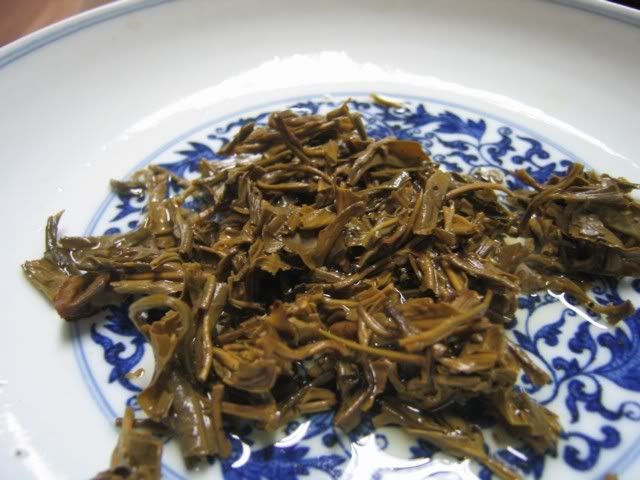
(It’s an accident that it’s in a star shape)
Does it look like green tea to you? It does to me, and it smelled like it too. Ovendried, and I think overdried, tea, that will not age thanks to it being not really puerh, but just high-temperature dried green tea. Tastes nice initially, but nasty after a few infusions. Buyer beware.
Then we tried two unremarkable iron cakes that are somewhat similar to the Nanzhao. I honestly don’t have much to say about them, other than they all taste quite similar to me. I don’t find them very exciting.
Then there was another tea… a Baoyan Mushroom, specially made also, I think, for Feitai, and probably two years old if I am not mistaken.
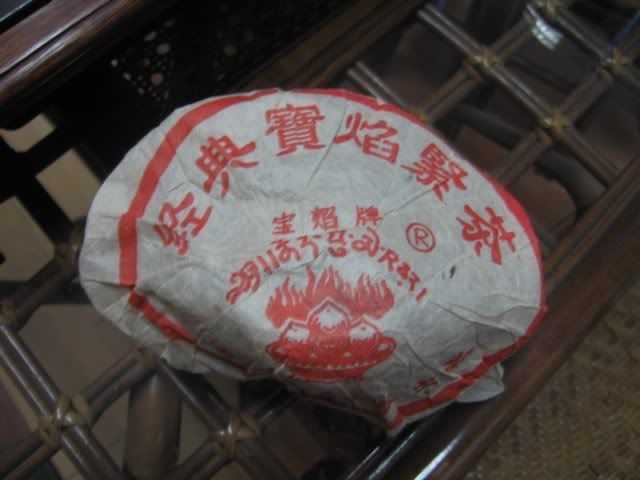
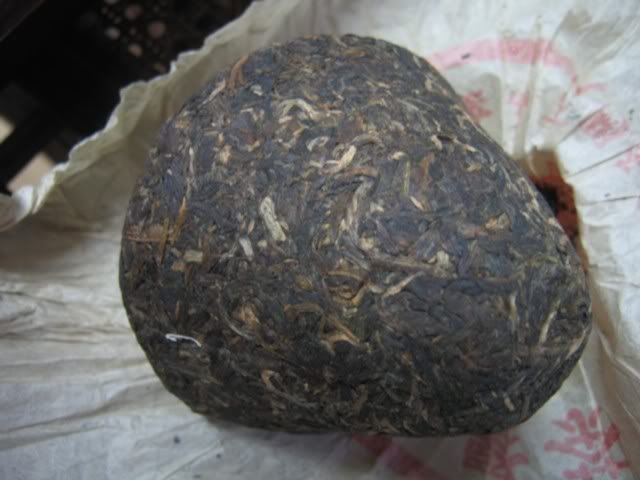

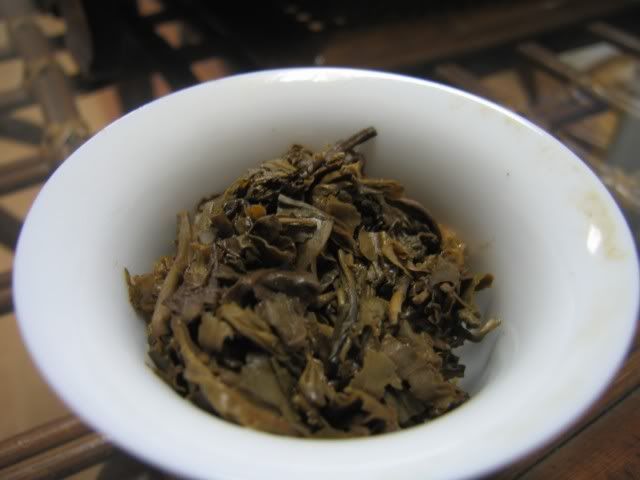
It comes in a nice special gift box, all wrapped up nicely. The reason we tried it was because after I showed him the 2002 Mengku cake (which he and his friend bought two tongs of) he realized that this is Mengku tasting… and it is. It tastes like the 2002 cake. Quite similar, and definitely Mengku. You can’t mistake it for anything else.
At this point, I was really drained by all the tea. It was…. a lot. I brought the 2004 Yangqing Hao to share with him, and we ended the day’s tasting with that, and I have to say I prefer that (or any good, big tree tea) over what I’ve tasted. It’s a different style, and it depends on what kind of taste you like. He likes the more heavy hitting, powerful, and “wow” teas that make an immediate impact. I guess I am more into drinking a little more slowly, stuff that is more mellow, that don’t necessarily wow you right away, but after a while you do realize that you’re drinking good tea afterall. As W observed when we started tasting the Yangqing Hao — this is a tea that is for sipping, and is quite subdued. He was, I think, interested in it, and thought it will age well as well with a comple
x taste in the future — and how the tea fills your mouth with various kinds of flavours, each brew being somewhat different. It was a nice finish to an interesting tea drinking day.
He gave me a tuo before we went off to dinner. This is also a Feitai tuo, I think, that is also, he thinks, made of Mengku materials. The packaging is the same as pretty much any other Teji Tuo

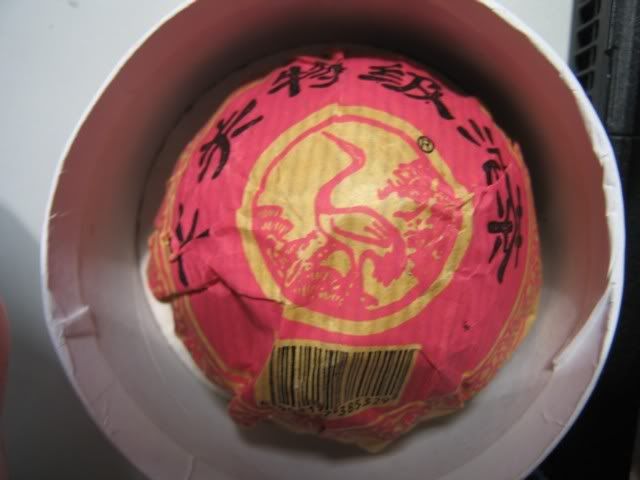
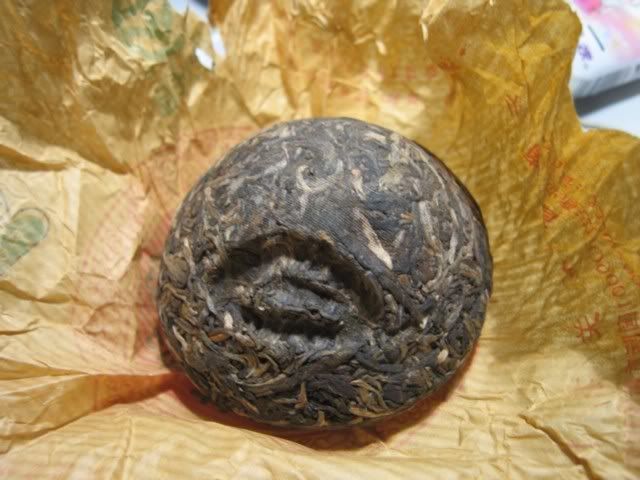
The tea doens’t look much different than your usual XG tuo, but the smell…. smells like Mengku tea. I’ll try it at some point. However, not all Teji use Mengku leaves. In fact, the September production (this is 04 May) that he owns does not taste like this one at all. Go figure. You can never tell unless you know what each region tastes like.
Tea really brings various kinds of people together…. And then there’s the Zhongcha visit tomorrow….

0 responses so far ↓
There are no comments yet...Kick things off by filling out the form below.